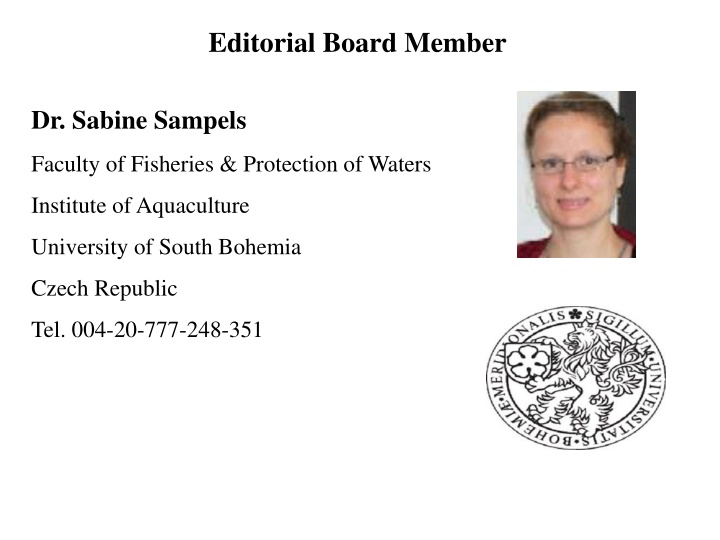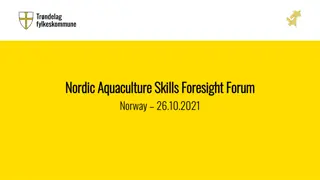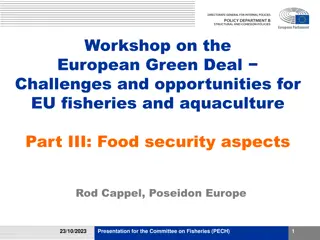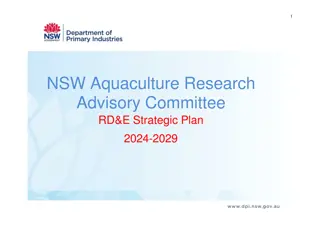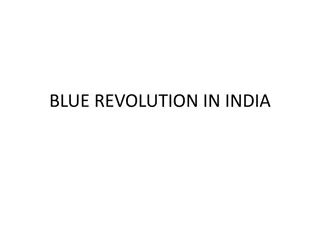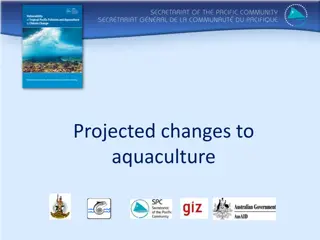Dr. Sabine Sampels: Research on Aquaculture, Fish Quality, and Human Health
Dr. Sabine Sampels, a member of the Editorial Board at the University of South Bohemia, Czech Republic, specializes in studying the effects of fish consumption on human health, animal nutrition on fish quality, and lipid metabolism. With a background in Food Chemistry and extensive research experience, she focuses on enhancing the nutritional value and safety of fish products through her work at the Institute of Aquaculture. Dr. Sampels has published numerous studies on fish lipid composition, oxidation, and antioxidants, contributing valuable insights to the field of aquaculture and food science.
Download Presentation

Please find below an Image/Link to download the presentation.
The content on the website is provided AS IS for your information and personal use only. It may not be sold, licensed, or shared on other websites without obtaining consent from the author.If you encounter any issues during the download, it is possible that the publisher has removed the file from their server.
You are allowed to download the files provided on this website for personal or commercial use, subject to the condition that they are used lawfully. All files are the property of their respective owners.
The content on the website is provided AS IS for your information and personal use only. It may not be sold, licensed, or shared on other websites without obtaining consent from the author.
E N D
Presentation Transcript
Editorial Board Member Dr. Sabine Sampels Faculty of Fisheries & Protection of Waters Institute of Aquaculture University of South Bohemia Czech Republic Tel. 004-20-777-248-351
Biography Dr. Sabine Sampels, PhD studied Food Chemistry at Rheinische Friedrich Wilhlems Universit t, Bonn, Germany and received her PhD at the Department of Food Science, Swedish University of Agricultural Sciences. After her Dissertation she worked at different Institutes in Sweden and Norway with quality of fish and fish products and the effect of dietary fatty acid composition on human health. Currently she has a position as a researcher at the University of South Bohemia in Ceske Budejovice, Faculty of Fisheries and Protection of Waters, Institute of Aquaculture focused on the quality safety and shelf life of fish and fish products, novel ingredients in fish products to increase nutritional value and effects of fish consumption on human health.
Research Interests Aquaculture and effects of consumption of fish on human health. Effect of animal nutrition on fish and meat compsoition. Fish and fish products assessment . Lipids and lipid metabolism in animal products and human nutrion. Shelf life, oxidation and antioxidants in fish and meat.
Publications Sampels S., Zaj c T., Mr z J., 2014, Effect of frying fat and preparation on carp (Cyprinus carpio) fillet lipid composition and oxidation. Czech Journal of Food Sciences, ISSN: 1212-1800. Sampels, S., Lev , E., Mr z, J., Vejsada, P., Zaj c, T., 2014, Kvalita a gastronomie ryb a ryb ch v robk , Jiho esk univerzita v esk ch Bud jovic ch, Fakulta ryb stv a ochrany vod, Z ti 728/II, 389 25 Vod any, p. 252, ISBN 978-80-87437-85-8 (Czech book) Zajic, T., Mraz, J., Sampels, S., Pickova, J., 2013, Fillet quality changes as a result of purging of common carp (Cyprinus carpio L.) with special regard to weight loss and lipid profile. Aquaculture, 400- 401, 111-119, ISSN: 0044-8486.
Sampels, S., 2013,Oxidation and Antioxidants in Fish and Meat from Farm to Fork. In: Muzzalupo, I. (Ed.), Food industry. InTech, Rijeka, Croatia, pp. 115 144. ISBN 980-953-307-860-6. (Book chapter) Zaj c, T., Mr z, J., Sampels, S., Pickova, J., 2013. Aplikace technologie finishing feeding do chovu ryb v praktick ch podm nk ch esk ho ryb stv . Edice Metodik, FROV JU, Vod any, . 137, p. 38 (Czech certified methodology) Sabine Sampels (2013) Processing and Preparation-Two Key Issues to Increase and Preserve Nutritional Value of Fish and Meat Products. J Fisheries Livest Prod 1: 1 Sampels, S., Pickova, J.,2011, Comparison of two different methods for the separation of lipid classes and fatty acid methylation in reindeer and fish muscle, Food Chemistry, 128 811 819.
Sampels, S., Pickova, J., Hgberg, A., Neil, M., 2011, Fatty acid transfer from sow to piglet differs for different polyunsaturated fatty acids (PUFA), Physiological Research, 60. Sampels, S., 2010, Metabolism and interaction of fatty acids, antioxidants, and biological active substances in animal muscle and consequent quality of animal foods. In: Lipids: Categories, Biological Functions and Metabolims, Nutrition and Health; Editor: Columbus F.; Nova Science Publishers, New York, pp. 45-70. Pickova, P., Sampels, S., Berntsen, M., 2010, Minor components in Fish Oil and Alternative Oils with Potential Physiological Effect. In: Fish Oil Replacement and Alternative Lipid Sources in Aquaculture Diets. Editors: Turchini, G.M.; Ng, W.K.; Tocher, D.R.; CRC Press, Taylor and Francis Group, p. 351 372.
Sampels, S., Turner, T., ststrm ., Pickova, J., 2010, Metabolism of -linolenic- and eicosapentaenoic acid from linseed and algae respectively in reindeer muscle, Acta Agriculturtae Scandinavica A, 60, 175-186. Sampels, S., sli, M., M rk re, T., 2010, Storage stability and antioxidant content of herring marinated with different berry extracts. Journal of Agricultural and Food Chemistry, 58, 12230-12237. Lindahl, G., Lagerstedt, A., Ertbjerg, P., Sampels, S., Lundstrom, K., 2010, Ageing of large cuts of beef loin in vacuum or high oxygen modified atmosphere effect on shear force, calpain activity, desmin, degradation and protein oxidation, Meat Science, 85(1), 160-166.
Sampels S., Strandvik B., Pickova J, 2009, Processed Animal Products with Emphasis on Polyunsaturated Fatty Acid Content. European Journal of Lipid Science and Technology., Vol. 111, 481- 488. Strandvik, B., Eriksson, S., Garemo, M., Palsdottir, V., Sampels, S., Pickova, J., 2008, Is the relatively low intake of n-3 fatty acids in Western diet contributing to the obesity epidemics? Lipid Technology, Vol. 20, Nr.3, 2-4. Svetlana A. Lanina S.A., Toledo P., Sampels S., Kamal-Eldin A., Jastrebova J.A., 2007, Comparison of reversed-phase liquid chromatography mass spectrometry with electrospray and atmospheric pressure chemical ionization for analysis of dietary tocopherols; Journal of Chromatography A, 1157 (2007) 159 170 Sampels,S., Pickova, J. & Wiklund, E., 2006, Influence of Diet on Fatty Acids and Tocopherols in M. Longissimus Dorsi from Reindeer; Lipids, Vol. 41, no. 5 , 463-472
Wiklund, E., Sampels, S., Manley, T.R., Pickova, J. & Littlejohn, R. P., 2006, Effects of feeding regimen and chilled storage on water holding capacity, colour stability, pigment content and oxidation in red deer (Cervus elaphus) meat; Journal of the Science of Food and Agriculture, 86, 98-106. Sampels,S., Pickova, J. & Wiklund, E., 2005. Influence of production system, age and sex on carcass parameters and some biochemical meat quality characteristics of reindeer (Rangifer tarandus tarandus L.); Rangifer, 25 (2): 85-96 Sampels, S. 2005. Fatty Acids and antioxidants in reindeer and red deer - emphasis on animal nutrition and consequent meat quality. Acta Universitatis Agriculturae Suecia, 2005:31 Swedish University of Agriculture Uppsala, Sweden.
Wiklund, E., Pickova, J., Sampels, S., & Lundstrm, K. 2001. Fatty acid composition in M. longissimus lumborum, ultimate muscle pH values and carcass parameters in reindeer (Rangifer tarandus tarandus L) grazed on natural pasture or fed a commercial feed mixture; Meat Science, 58, 293-298. Sampels,S., Pickova, J. & Wiklund, E., 2004. Fatty acids, antioxidants and oxidation stability of processed reindeer meat; Meat Science, 67, 523-532 Wiklund, E., Johansson, L., Sampels, S. and Malmfors, G. 2004. Tasty and healthy meat from the North. Food Science Central. Available at http://www.foodsciencecentral.com/library.html#ifis/13583
Aquaculture Aquaculture is the farming of aquatic organisms such as fish, prawns, molluscs, and aquatic plants related directly or indirectly to human consumption. Over recent years, world seafood consumption has risen and overall production has increased. However,wild-caught production has remained stable, Aquaculture has therefore become increasingly important in meeting local and global demand for seafood.
Stock restoration or "enhancement" is a form of aquaculture in which hatchery fish and shellfish are released into the wild to rebuild wild populations or coastal habitats such as oyster reefs Aquaculture also includes the production of ornamental fish for the aquarium trade, and growing plant species used in a range of food, pharmaceutical, nutritional, and biotechnology products.
Marine Aquaculture Marine aquaculture refers to the culturing of species that live in the ocean U.S. marine aquaculture primarily produces oysters, clams, mussels, shrimp, and salmon as well as lesser amounts of cod, moi, yellowtail, barramundi, seabass, and seabream. Marine aquaculture can take place in the ocean (that is, in cages, on the seafloor, or suspended in the water column) or in on-land, manmade systems such as ponds or tanks.
Freshwater Aquaculture Freshwater aquaculture produces species that are native to rivers, lakes, and streams. U.S. freshwater aquaculture is dominated by catfish but also produces trout, tilapia, and bass. Freshwater aquaculture takes place primarily in ponds and in on- land, manmade systems such as recirculating aquaculture systems
Production Where are the best places to put an aquaculture farm? There are specific criteria that must be considered when investigating a potential site for aquaculture. These include water access, topography, climate, soil type, and proximity to markets, support and infrastructure.
Agriculture Planning Process STAGE ONE: Preparation and Submission of Application In the initial instance the developer will approach the Local Planning Authority The LPA will advise the developer to consult with relevant parties, this is not a legal requirement but it is a requirement of industry protocol STAGE TWO: Consultation, Consideration and Determination The Planning Authority may provide a planning permission, which will allow it to assess some of the impacts of the development before considering whether to grant permanent permission.
STAGE THREE: Appeal The applicant has the right to appeal any decision for refusal, or any conditions attached to an approval. The Decision is usually made under delegated powers by a local planning officer. If a statutory consultee has objected, the application will be determined by the council committee instead of being delegated to a planning officer, this has a bearing on the route of appeal by the applicant
Aquaculture Feed The main operating cost of intensive aquaculture ventures feed, and many ventures fail due to excessive spending on this input. Larger, warm water projects are now carefully scrutinizing feed costs. It is generally accepted that feed constitutes 40% to 60% of all recurring expenses in a re-circulating aquaculture system (RAS). This is a very high figure, so wastage cannot be tolerated.
Controlling diseases in aquaculture systems Species-specific :Many fish diseases are species-specific and are brought on by different conditions. For example, poor quality water affects trout and tilapia in different ways. Parasitic infections such as Ichthyophthirius multifiliis (ich) and costia (white spot diseases) are often opportunistic and attack weakened fish. Fungal infections and sensitivity Fungus may also develop on tilapia exposed to low temperatures. It is of little use to treat the fungus, as it is a secondary affliction the water must be warmed. Some fish strains are more sensitive than others
Algae control : Ultraviolet (UV) sterilization is a useful tool in RAS disease control, both to eliminate pathogens and for uni-cellular algae control. If a system is carrying a high nitrate load, green water will almost certainly be a problem, resulting in fish and algae competing for oxygen. UV lamps of sufficiently high output and used for extended periods can control algae very effectively. These are fitted in the filtration system behind the pumps, before the water is returned to the fish tanks. These UV lamps result in clear, pathogen-free water
Fish breeding do's & don'ts If you breed two genetically closely-related individuals of the same species, you automatically lose genetic variability but the golden rule is to breed livestock to improve their attributes for aquaculture, and not breed inbred, low quality runts. The frequent inbreeding of siblings (brother/sister or father/daughter) usually has two results. Certain traits become more fixed (be they good or bad) and the general health of the fish deteriorates. > > >
If all the fish in a particular population (thousands of individuals) are fast-growing, with deep body shape and a late onset of maturity, this may be an indicator of high-quality stock for aquaculture. But that can only be ascertained by an intensive scientific examination of their life history. Only once that has been documented can one say that a particular population, or strain , is of high quality, and even then these attributes may not be as well expressed under aquaculture conditions as in the wild.
Fish Farming Methods The first method is the cage system which use cages that are placed in lakes, ponds and oceans that contain the fish. This method is also widely referred to as off-shore cultivation. Fish are kept in the cage like structures and are artificiallyfed and harvested. The second method is irrigation ditch or pond systems for raising fish. This basic requirement for this method is to have a ditch or a pond that holds water. This is a unique system because at a small level, fish are artificially fed and the waste produced from the fish is then used to fertilize farmers fields.
The third method of fish farming is called composite fish culture which is a type of fish farming that allows both local fish species and imported fish species to coexist in the same pond. The number of species depends, but it is sometimes upwards of six fish species in a single pond. The fourth method of fish farming is called integrated recycling systems which is considered the largest scale method of pure fish farming. This approach uses large plastic tanks that are placed inside a greenhouse The last type of fish farming method is called classic fry farming this method is also known as flow through system . This is when sport fish species are raised from eggs and are put in streams and released.
Thank You..! Thank You..!
